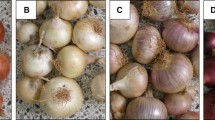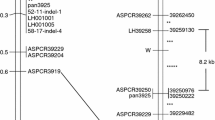Abstract
Bulb color in onions (Allium cepa) is an important trait, but the mechanism of color inheritance is poorly understood at the molecular level. A previous study showed that inactivation of the dihydroflavonol 4-reductase (DFR) gene at the transcriptional level resulted in a lack of anthocyanin production in yellow onions. The objectives of the present study were the identification of the critical mutations in the DFR gene (DFR-A) and the development of a PCR-based marker for allelic selection. We report the isolation of two additional DFR homologs (DFR-B and DFR-C). No unique sequences were identified in either DFR homolog, even in the untranslated region (UTR). Both genes shared more than 95% nucleotide sequence identity with the DFR-A gene. To obtain a unique sequence from each gene, we isolated the promoter regions. Sequences of the DFR-A and DFR-B promoters differed completely from one another, except for an approximately 100-bp sequence adjacent to the 5′UTR. It was possible to specifically amplify only the DFR-A gene using primers designed to anneal to the unique promoter region. The sequences of yellow and red DFR-A alleles were the same except for a single base-pair change in the promoter and an approximately 800-bp deletion within the 3′ region of the yellow DFR-A allele. This deletion was used to develop a co-dominant PCR-based marker that segregated perfectly with color phenotypes in the F2 population. These results indicate that a deletion mutation in the yellow DFR-A gene results in the lack of anthocyanin production in yellow onions.





Similar content being viewed by others
References
Bastianetto S, Quirion R (2002) Natural extracts as possible protective agents of brain aging. Neurobiol Aging 5687:1–7
Bharti A, Khurana J (2003) Molecular characterization of transparent testa (tt) mutants of Arabidopsis thaliana (ecotype Estland) impaired in flavonoid biosynthesis pathway. Plant Sci 165:1321–1332
Braca A, Sortino C, Politi M, Morelli I, Mendez J (2002) Antioxidant activity of flavonoids from Licania licaniaeflora. J Ethnopharmacol 79:379–381
Clarke AE, Jones HA, Little TM (1944) Inheritance of bulb color in the onion. Genetics 29:569–575
Cook NC, Samman S (1996) Flavonoids—chemistry, metabolism, cardioprotective effects, and dietary sources. Nutr Biochem 7:66–76
Davis GN, El-Shafie MW (1967) Inheritance of bulb color in the onion (Allium cepa L.). Hilgardia 38:607–622
Dooner HK, Robbins TP (1991) Genetic and developmental control of anthocyanin biosynthesis. Annu Rev Genet 25:173–199
Endt DV, Kijne JW, Memelink J (2002) Transcription factors controlling plant secondary metabolism: what regulates the regulators?. Phytochemistry 61:107–114
Fossen T, Andersen OM, Ovstedal DO, Pedersen AT, Raknes A (1996) Characteristic anthocyanin pattern from onions and other Allium spp. J Food Sci 61:703–706
Fuleki T (1971) Anthocyanins in red onion, Allium cepa. J Food Sci 36:101–104
Goodrich J, Carpenter R, Coen ES (1992) A common gene regulates pigmentation pattern in diverse plant species. Cell 68:955–964
Hollman PCH, Katan MB (1997) Absorption, metabolism and health effects of dietary flavonoids in man. Biomed Pharmacolther 51:305–310
Holton TA, Cornish EC (1995) Genetics and biochemistry of anthocyanin biosynthesis. Plant Cell 7:1070–1083
Keli S, Hertog M, Feskens E, Kromhout D (1996) Flavonoids, antioxidant vitamins and risk of stroke. The Zutphen study. Arch Intern Med 156:637–642
Kim S, Binzel M, Yoo K, Park S, Pike L (2004a) Inactivation of DFR (dihydroflavonol 4-reductase) gene transcription results in blockage of anthocyanin production in yellow onions (Allium cepa). Mol Breed 14:253–263
Kim S, Binzel M, Yoo K, Park S, Pike LM (2004b) Pink (P), a new locus responsible for a pink trait in onions (Allium cepa) resulting from natural mutations of anthocyanidin synthase. Mol Gen Genomics 272:18–27
King JJ, Bradeen JM, Bark O, McCallum JA, Havey MJ (1998) A low-density genetic map of onion reveals a role for tandem duplication in the evolution of an extremely large diploid genome. Theor Appl Genet 96:52–62
Knekt P, Jarvinen R, Reunanen A, Maatela J (1996) Flavonoid intake and coronary mortality in Finland: a cohort study. Br Med J 312:478–481
Kobayashi T, Nakata T, Kuzumaki T (2002) Effect of flavonoids on cell cycle progression in prostate cancer cells. Cancer Lett 176:17–23
Li J, Ou-Lee T, Raba R, Amundson R, Last R (1993) Arabidopsis flavonoid mutants are hypersensitive to UV-B irradiation. Plant Cell 5:171–179
Mol J, Jenkins G, Schafer E, Weiss D (1996) Signal perception, transduction, and gene expression involved in anthocyanin biosynthesis. Crit Rev Plant Sci 15:525–557
Quandt K, Rrech K, Karas H, Wingender E, Werner T (1995) matind and matinspector—new fast and versatile tools for detection of consensus matches in nucleotide sequence data. Nucleic Acids Res 23:4878–4884
Quattrocchio F, Wing JF, Leppen HTC, Mol JN, Koes RE (1993) Regulatory genes controlling anthocyanin pigmentation are functionally conserved among plant species and have distinct sets of target genes. Plant Cell 5:1497–1512
Reiman GH (1931) Genetic factors for pigmentation in the onion and their relation to disease resistance. J Agric Res 42:251–278
Rhodes MJC, Price KR (1996) Analytical problems in the study of flavonoid compounds in onions. Food Chem 57:113–117
Shirley BW (1996) Flavonoid biosynthesis: ‘new’ functions for an ‘old’ pathway. Trends Plant Sci 1:377–382
Spelt C, Quattrocchio F, Mol JN, Koes RE (2000) anthocyanin1 of Petunia encodes a basic helix-loop-helix protein that directly activates transcription of structural anthocyanin genes. Plant Cell 12:1619–1631
Yamazaki M, Makita Y, Springob K, Saito K (2003) Regulatory mechanisms for anthocyanin biosynthesis in chemotypes of Perilla frutescens var. crispa. Biochem Eng J 14:191–197
Zeback R, Dressler K, Hess D (1989) Flavonoid compounds from pollen and stigma of Petunia hybrida: inducers of the vir region of the Agrobacterium tumefaciens Ti plasmid. Plant Sci 62:83–91
Acknowledgements
The authors thank members of Vegetable and Fruit Improvement Center for their dedicated support of this research. We gratefully acknowledge the proofreading by Dr. Marla Binzel. This work was supported by produce industry member contributions to the Vegetable and Fruit Improvement Center and U.S. Department of Agriculture grant (CSREES 2001-34402-10543, “Designing Foods for Health”).
Author information
Authors and Affiliations
Corresponding author
Additional information
Communicated by I. Paran
Rights and permissions
About this article
Cite this article
Kim, S., Yoo, K.S. & Pike, L.M. Development of a PCR-based marker utilizing a deletion mutation in the dihydroflavonol 4-reductase (DFR) gene responsible for the lack of anthocyanin production in yellow onions (Allium cepa). Theor Appl Genet 110, 588–595 (2005). https://doi.org/10.1007/s00122-004-1882-7
Received:
Accepted:
Published:
Issue Date:
DOI: https://doi.org/10.1007/s00122-004-1882-7




